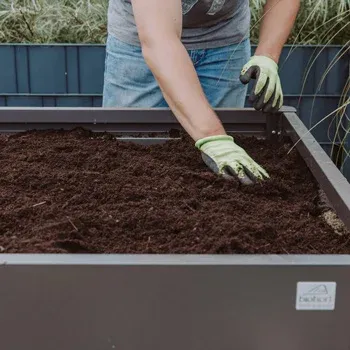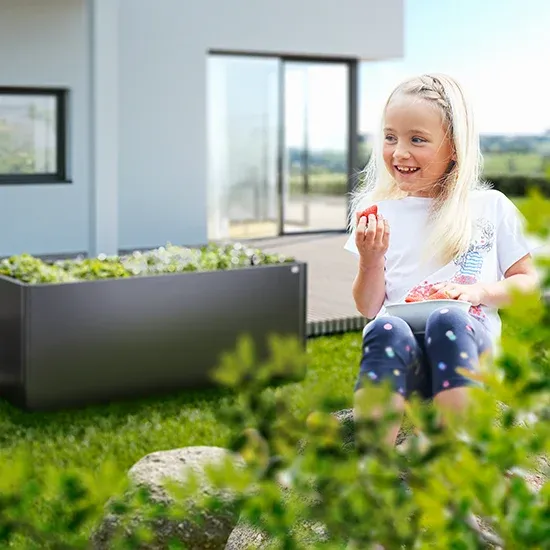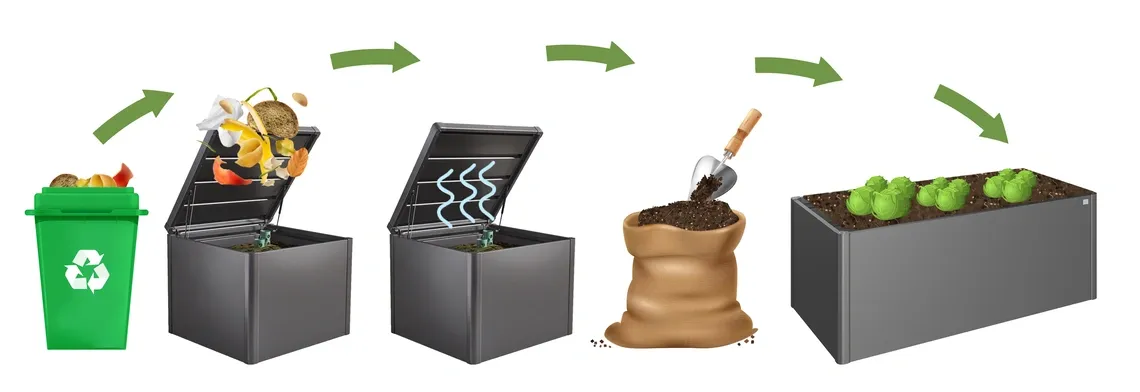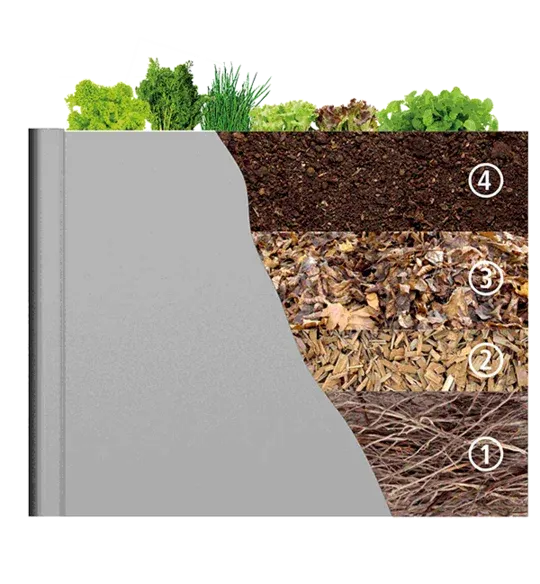Filling Raised Beds Correctly

Raised beds are a great way to grow delicious fruit, vegetables and herbs in your own garden or on your patio. To maximise the harvest, a nutrient-rich soil is essential and it is (usually) not enough to just fill the raised bed with soil. The correct filling of the raised bed is much more important as the key to success, and there are different ways to fill a raised bed. In this article, we reveal a great and simple way to fill your raised bed with just four layers and summarise the most important information on this topic.
- Finding the perfect raised bed
- Choosing a location for the raised bed
- How to fill a raised bed correctly
- Why should you fill a raised bed in layers?
- When is the best time to fill a raised bed?
- Filling material required for the raised bed
- Protection from rodents
- Four layers for filling the raised bed
- Other to-do'ss after creating a raised bed
Finding the perfect raised bed
Raised beds can be made from a wide variety of materials, such as metal, wood or plastic. The choice of material influences, among other things, the durability and appearance of the raised bed. For those who place particular value on stability and durability, we recommend raised beds made from hot-dip galvanised sheet. The material has excellent thermal insulation properties. This means that the soil in the raised bed warms up more quickly and the plants in it can thrive faster and better.

Choosing a location for the raised bed
On the way to the perfect raised bed , you first need to find the ideal location for it in your own garden or on the patio. Choosing the right location is particularly important for a successful harvest. Ideally, you should choose a sunny to semi-shady location that receives at least six hours of sunlight per day. Shady locations should be avoided. A level base is also important to prevent the raised bed from sinking.
How to fill a raised bed correctly
Basically, we recommend that the raised bed should consist of different layers and should therefore also be filled in layers. The height of the individual layers depends on the height of the raised bed as well as the availability of the respective materials. The lowest layer is the coarsest - consisting of branches, for example - the layers then become finer and finer towards the top and therefore also denser.
Why fill a raised bed in layers?
The layered filling with different materials triggers the formation of humus, which can supply the raised bed with important nutrients for many years. In order to achieve a good nutrient mix, a wide variety of natural materials are required, which release nutrients through their natural decomposition in the raised bed. These nutrients in turn have a positive effect on the growth of the plants and the fertility of the raised bed. When is the best time to fill a raised bed? The best time to start filling a raised bed is definitely autumn. The leaves and garden waste that accumulate at this time of year are available in abundance and can be used immediately in the raised bed.
Pro tip:
You can of course start collecting the materials for filling the raised bed in summer. The collected filling material such as green cuttings, tree and shrub cuttings or compost can then be used in autumn.

Filling material required for the raised bed
Before you can really get started, you need to think about the right filling material and get it in sufficient quantities. There are basically various materials that can be used as filling for a raised bed. Popular options include leaves, green cuttings and compost. If you have your own composter in the garden, you can of course also use your own composted soil for the raised bed.
Here is a short checklist of suitable filling material for a raised bed:
- leaves
- green cuttings
- compost
- lawn cuttings
- tree or shrub cuttings such as branches and twigs
- rotten wood
- woodchips/wood shavings
- mulch and/or straw
- garden soil or special raised bed soil
materials, that are not suitable as filling material for a raised bed are, for example, prunings from thujas, conifers or ivy. Ivy in particular proliferates extremely strongly and can overgrow the entire raised bed. You should also avoid using seed-bearing perennial or vegetable residues, as these can germinate unintentionally in the raised bed.
Protection from rodents
Once you have collected the filling material and the raised bed is in the chosen location, there is one more extremely important step on the programme before you can start with the actual filling: Protecting the raised bed from rodents. The raised beds from Biohort, for example, already have integrated rodent protection made of sturdy fibreglass fabric. This saves you this tedious work step.
Four layers for filling the raised bed
Once all the preparations have been made, you can start filling the raised bed in layers. Here's how it's done:
1. Rough base layer
The lowest and therefore first layer contains coarse garden waste such as branches, rootstocks, twigs, rotten wood and other prunings. Gravel or wood chips can also be incorporated into the base layer. This base is also known as a "drainage layer". When filling the base layer, care should be taken to ensure that the filling material is not compacted too much. The coarse material ensures that no waterlogging occurs and that the water in the raised bed can drain away easily. 2. Finely chopped green waste This is followed by a layer of organic materials such as finely chopped green and wood cuttings, plant residues and grass cuttings to further loosen the soil and provide nutrients. You can also work some straw into the filling quantity here.
3. Compost and leaves
The third layer consists of dry and wet leaves and compost. This layer is a real source of strength, as it contains a particularly large amount of nutrients that are essential for good plant growth. The constant rotting process in the raised bed gradually produces more compost from the lower layers, which provides important nutrients for several years.
4. Garden soil
The last and also visible top layer of the raised bed consists of high-quality garden soil, which should also be rich in nutrients. It is best to use a very high-quality potting soil, as this layer is the one in which the plants thrive and grow. The soil should be filled to just below the edge of the bed.
Pro tip:
A final, thin layer of mulch can help to retain moisture and minimise weed growth in the raised bed.

4. GARDEN SOIL
High-quality potting soil, humus or compost provide ideal conditions for good rooting and optimum plant growth.
3. COMPOST AND LEAVES
The generously sized middle core comprising compost and leaves releases important nutrients and heat.
2. FINELY CHOPPED MATERIAL OR GRASS
This layer prevents smaller components seeping through from above.
1. BRANCHES OR TWIGS
The lowest layer guarantees adequate ventilation from below for even rotting.
Further to-do's after creating a raised bed
Once the inside of the raised bed is ready, you have already laid the most important foundation stone for a nutrient-rich and productive raised bed. In order to utilise the raised bed optimally, a few small details should be taken into account.
Watering
Correct and, above all, sufficient watering of the raised bed is particularly important in order to achieve an optimum harvest. Overwatering, on the other hand, should be avoided at all costs. A good rule of thumb is to water the raised bed really thoroughly at least once a week and to check regularly whether the raised bed is sufficiently moisturised. In summer and on particularly hot days, the bed should of course be watered daily. An automatic watering system can do a lot of the work for you. The raised beds from Biohort, for example, already have an integrated preparation for an irrigation hose.
Plant selection
Cucumbers, courgettes, kohlrabi, radishes and carrots are particularly popular plants for raised beds. A wide variety of herbs, flowers and fruit, such as strawberries, also thrive in raised beds. There are a few things to consider when choosing plants for the raised bed. For example, there are plants that do not get along so well as direct bed neighbours. Tomatoes, for example, should not be planted directly next to peas or potatoes.
And there are also a few things to bear in mind when sowing. With the Biohort sowing calendar , you have a practical aid at hand and always have the most important information on ideal sowing times or the germination period to hand.
Care of the raised bed
Continuous care of the raised bed is just as important in order to achieve a high-yield harvest. Weeds and overgrown plants should be regularly removed or thinned out to create enough space for the other plants in the bed. The raised bed should also be fertilised with some organic fertiliser from the second year onwards to maintain the nutrients in the soil.
Filling the raised bed in spring
A raised bed sinks over the months and steadily loses volume. This is a completely natural process that is driven by the rotting of the individual layers. However, the lost height can easily be replenished by adding more potting soil. Ideally, the raised bed should always be refilled in spring before the first plants and seeds of the new gardening season are planted.
Refilling raised beds
The natural nutrients in a raised bed are used up after a few years. It is therefore necessary to completely renew the interior and the individual layers from time to time. This is usually the case after five to seven years. As a full raised bed, including its contents, can easily weigh several hundred kilograms, it is advisable to opt for a version that is easy to refill at the time of purchase. You'd rather not have to imagine the hassle of shovelling out the contents, and you can definitely do without it. ;-)
The Biohort raised bed, for example, guarantees easy emptying thanks to its easy-to-open side panels.

A raised bed filled with quality content guarantees years of enjoyment for amateur gardeners. Creating a raised bed can be a rewarding and truly enjoyable experience if you take your time and do it right. We wish you much success and enjoyment when filling your raised bed and many rich harvests.
